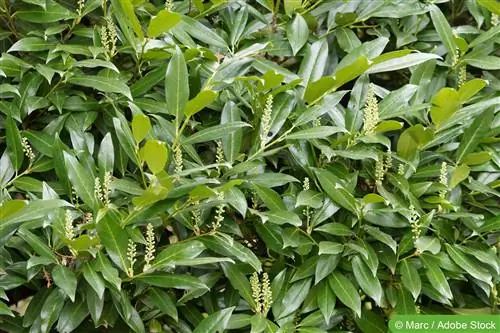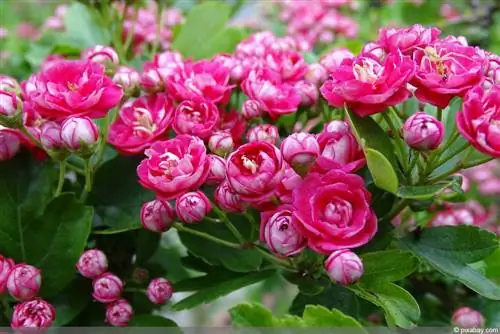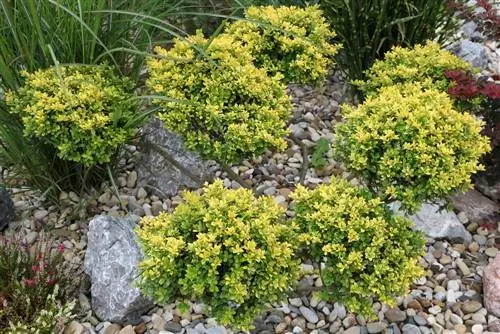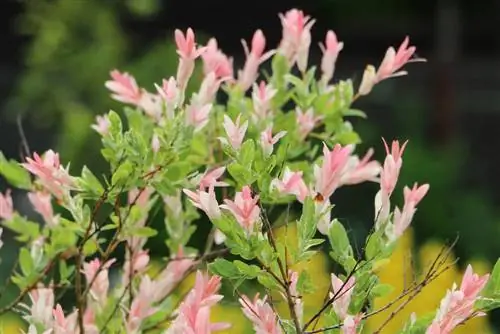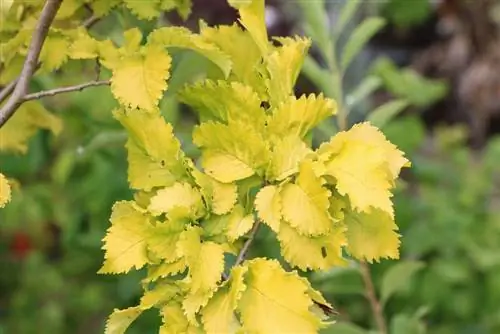- Author admin [email protected].
- Public 2023-12-17 03:39.
- Last modified 2025-01-24 12:45.
The cherry laurel, cherry laurel or Prunus laurocerasus is an evergreen shrub that is particularly easy to care for. Individually or as a hedge, it is always an eye-catcher in the garden thanks to its rich color. Little can change this beauty, because it is not only undemanding, but also robust and resilient.
If you want to make your garden easy to care for but still lush, green and versatile, you will find the right plant in the laurel cherry. It has few requirements, but in the right location it is extremely long-lasting and he althy. She can even easily forgive mistakes in care. This makes it ideal for beginners in the garden. The evergreen plant only requires a few measures, but these should of course be adapted. Then the cherry laurel will last for a long time.
Location
The laurel cherry thrives best in a shady location. A place with light shade also suits the plant well. The cherry laurel only needs to be protected from the blazing sun. A location in the south is therefore extremely unsuitable. The shrub feels most comfortable surrounded by shady trees and other plants. A wall or house wall can also serve this purpose. This environment has another advantage as it also protects the Prunus laurocerasus from wind. This protection also prevents winter damage, but ensures better prosperity all year round.
Substrate
As a fast-growing plant, the laurel cherry requires large amounts of nutrients, at least at the beginning. The ideal substrate is therefore composed of the following components:
- fresh garden soil
- ripe compost
- stable manure
The mixture can consist of equal parts. If the garden soil tends to become compacted, a little sand should also be mixed into it. This addition keeps it loose and the water can drain away better.
Plants
The laurel cherry can be planted in spring or autumn. To do this, proceed as follows:
- A hole must be dug that is at least twice as wide and deep as the root ball of the plant.
- The soil is first covered with the substrate mixture described above.
- The root ball is inserted so that it is flush with the earth's surface at the top.
- Finally, the free space around the roots is filled with substrate, tapped into place and watered.
Tip:
To accelerate growth, the planting hole can also be provided with horn shavings.
Pouring
The cherry laurel should be watered regularly within the first few months in the new location. After that, watering can be significantly reduced. Additional watering is only necessary in dry phases, when the substrate on the surface has dried out. However, waterlogging should never occur, as the cherry laurel cannot tolerate this. However, complete drying out should also be avoided.
Fertilize
If the soil is mixed as described and the planting hole is prepared accordingly with nutrients, further fertilization is hardly necessary.
However, it doesn't hurt to work compost, manure or horn shavings into the soil every now and then. The ideal time for this is in spring, when budding begins.
Tip:
If you spread a thick layer of bark mulch at the site, you can reduce the effort required for watering and fertilizing.
Intersection
The laurel cherry can basically be left to its own devices. However, its rapid growth means it takes up a lot of space in a very short time. The shape can be quite bulky and expansive. It is therefore a good idea to give the cherry laurel at least an annual trimming. On the one hand, this keeps the shape and size within the desired framework, and on the other hand, the measure has a rejuvenating effect.
It doesn't take much to make the laurel cherry blend, but you do need to have time. Since the plant has large leaves, it is much easier to cut it by hand. However, if electric or petrol-powered scissors are used, the leaves will appear shredded. This is not only visually disadvantageous, but also makes the plant more susceptible to disease. Pruning takes place in the spring before budding and may be radical. The ornamental tree can cope well with a cut into the old wood. However, depending on your wishes, the measure can also be limited to careful thinning.
Tip:
To shape the cherry laurel, it is recommended to use scissors more often throughout the year. Always when individual shoots get out of line.
Propagate
Interested hobby gardeners have three ways to propagate cherry laurel. Seeds, cuttings and planters are suitable.
Propagation via cuttings requires the least effort, but is also the fastest. The only way to be more certain about success is to form depressions. Cuttings are formed as follows:
- After budding in spring, approximately 15 cm long shoot tips are cut off from the cherry laurel.
- The lower leaves of the cuttings are removed.
- The head cuttings are planted four to five centimeters deep in potting soil or a mixture of peat and sand.
- The substrate is slightly moistened and kept that way throughout. Until then, the small cherry laurels should remain protected. The windowsill or a wind-free corner outdoors are suitable.
- If new shoots, leaves or buds appear on the cuttings, roots have formed.
- If significant growth has occurred, the young plants can be moved to their final location.
Wintering
The laurel cherries do not need any protection to overwinter. However, it is still advisable, especially in the event of severe frosts, to insulate the roots from cold wind with bark mulch and the plant itself with a light fleece layer.
Typical diseases and pests
Wilted leaves, delayed growth and discoloration - if these symptoms appear on the laurel cherry, a fungal infection is most likely the cause. Regular, leaf-friendly trimming and careful watering are ideal as prevention. If an infestation occurs, affected parts - if necessary the entire plant - should be removed. The use of a broad-spectrum fungicide is also recommended. The following are the main pests of cherry laurel:
- Aphids
- Mealybugs
- Scale insects
- mealybugs
- Bigmouth Weevil
The easiest and most effective way to get rid of various types of lice is through useful insects. Ladybugs, wasps, parasitic wasps and lacewings are particularly helpful. The black weevil is proving to be more stubborn. It should be collected at dusk. To do this, it is important to remove and replace the soil as deeply as possible. The use of nematodes is also promising.
Frequently asked questions
Is the laurel cherry poisonous?
The cherry laurel is poisonous in all parts and is therefore only partially suitable for gardens with small children and pets.
Can cherry laurel be grown in a pot?
Basically, it is possible to cultivate the laurel cherry in a bucket. Here, however, it needs to be watered, cut and fertilized more often.
What you should know about the Laurel Church in brief
The cherry laurel has nothing to do with the spiced laurel used in cooking. Another name for the laurel cherry is cherry laurel. However, you should avoid eating parts of the plant. The leaves, seeds and other parts of the plant are poisonous. Therefore, caution is also advised if small children or animals live in the household. Apart from that, the laurel cherry is a beautiful eye-catcher. The evergreen leaves have a rich, deep green color and an impressive shine. Since, as already mentioned, the plant retains its leaves even in winter, cherry laurel hedges are a good privacy screen.
Location
- Because the laurel cherry comes from warmer areas, it is very susceptible to frost.
- If frost damage has occurred, the leaves turn brown and fall off. This does not mean the end of the entire plant.
- The leaves sprout again in spring. Until then, the laurel cherry is quite unsightly.
- The location of the laurel cherry should be chosen exactly. Regarding her origins, she likes it warm.
- A place in full sun or partial shade is therefore the minimum requirement for the perfect place to feel good.
Pouring
- In addition, the laurel cherry doesn't like it too wet, but not too dry either.
- If watering is necessary, the soil should be at least superficially dry in between.
- Waterlogging should be avoided, as should the soil drying out completely. This makes the plant susceptible to diseases.
Fertilize
- Fertilizing the laurel cherry is usually not necessary. Too much of nutrients is more likely to be harmful.
- Applying a layer of mulch, on the other hand, is highly recommended.
Cutting
- The hedge should be trimmed back in the spring before budding.
- As the hedge gets older, thinning becomes a necessary job.
- The laurel cherry tolerates pruning very well.
- It often tolerates even radical cutting back, such as after an illness, without any problems.

